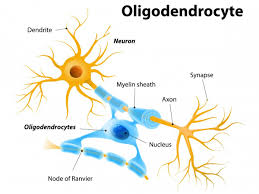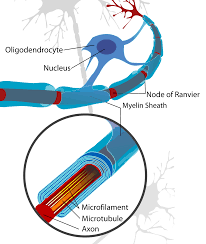
 Oligodendrocytes are a type of glial cell found in the central nervous system.
Oligodendrocytes are a type of glial cell found in the central nervous system.
These cells are responsible for producing myelin, which is an insulating material that surrounds axons, the long projections of neurons.
Myelin helps to speed up the transmission of electrical signals along axons, allowing for more efficient communication within the nervous system.
In addition to myelin production, oligodendrocytes also provide support and maintain the health of neurons in the brain and spinal cord.
Dysfunction of oligodendrocytes can lead to demyelinating diseases, such as multiple sclerosis, which can cause a range of neurological symptoms.
Oligodendrocyte
Oligodendrocytes are a type of neuroglia whose main functions are to provide support and insulation to axons in the central nervous system, equivalent to the function performed by Schwann cells in the peripheral nervous system.
Oligodendrocytes are a type of glial cell.
Oligodendrocytes create the myelin sheath.
A single oligodendrocyte can extend its processes to 50 axons, wrapping approximately 1 μm of myelin sheath around each axon.
Schwann cells, on the other hand, can wrap around only one axon.
Each oligodendrocyte forms one segment of myelin for several adjacent axons.
Oligodendrocytes are found only in the central nervous system, which comprises the brain and spinal cord.
Oigodendrocytes originate from the ventral ventricular zone of the embryonic spinal cord and possibly have some concentrations in the forebrain.
They are the last cell type to be generated in the central nervous system (CNS).
Mature oligodendrocytes are broadly classified into either myelinating or non-myelinating satellite oligodendrocytes.
Oligodendocytes are typically identified by their expression of the transcription factor OLIG2.
Myelin sheaths reduce ion leakage and decrease the capacitance of the cell membrane, for rapid signal conduction.
Myelin also increases impulse speed, as saltatory propagation of action potentials occurs at the nodes of Ranvier in between Schwann cells (of the PNS) and oligodendrocytes (of the CNS).
Impulse speed of myelinated axons increases linearly with the axon diameter, whereas the impulse speed of unmyelinated cells increases only with the square root of the diameter.
The insulation must be proportional to the diameter of the fiber inside.
The optimal ratio of axon diameter divided by the total fiber diameter is 0.6.
Myelination is only prevalent in a few brain regions at birth and continues into adulthood.
Myelination process is not complete until about 25–30 years of age.
Myelination is an important component of intelligence, and white matter quantity may be positively correlated with IQ test results in children.
Oligodendrocytes interact with nerve cells and provide trophic support to them by producing glial cell line-derived neurotrophic factor (GDNF), brain-derived neurotrophic factor (BDNF), or insulin-like growth factor-1 (IGF-1).
Oligodendrocytes may also directly provide metabolites to neurons.
Satellite oligodendrocytes/perineuronal oligodendrocytes, are functionally distinct from other oligodendrocytes in that they are not attached to neurons via myelin sheaths and, therefore, do not contribute to insulation.
Satellite oligodendrocytes/perineuronal oligodendrocytes remain opposed to neurons and regulate the extracellular fluid.
Satellite oligodendrocytes are considered to be a part of the grey matter whereas myelinating oligodendrocytes are a part of the white matter.
They may support neuronal metabolism.
Satellite oligodendrocytes may be produce new myelin after a demyelinating injury.
Diseases that result in injury to oligodendrocytes include demyelinating diseases such as multiple sclerosis and various leukodystrophies.
Trauma to the body, e.g. spinal cord injury, can also cause demyelination.
A congenital condition of damage to the newly forming brain can therefore lead to cerebral palsy.
In cerebral palsy, spinal cord injury, stroke and possibly multiple sclerosis, oligodendrocytes are thought to be damaged by excessive release of the neurotransmitter glutamate.
Damage also been mediated by N-methyl-D-aspartate receptors.
Oligodendrocyte dysfunction may also be implicated in the pathophysiology of schizophrenia and bipolar disorder.
Oligodendrocytes are also susceptible to infection by the JC virus, which causes progressive multifocal leukoencephalopathy (PML), a condition that specifically affects white matter, typically in immunocompromised patients.
Tumors of oligodendrocytes are called oligodendrogliomas.
